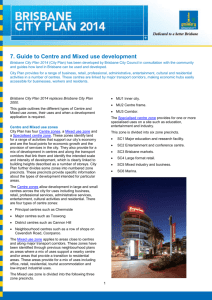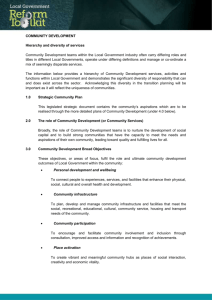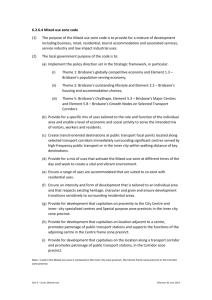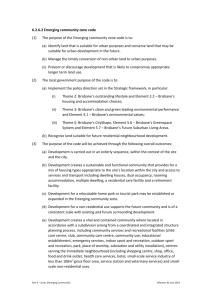Centre Provisions - Brisbane City Council
advertisement
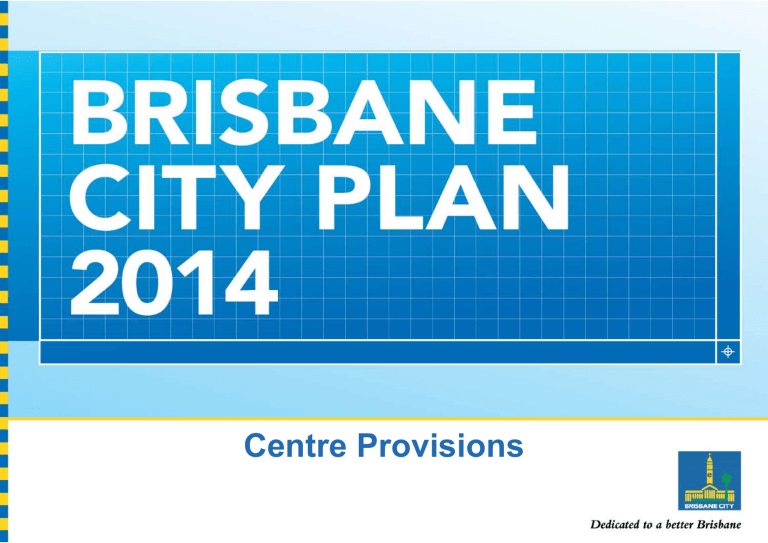
Centre Provisions Session Outline 1. Strategic framework – Brisbane’s centres 2. Centre and mixed use zones • Key points • Zone and zone precinct intents 3. Level of assessment and definitions 4. Centre and mixed use code • Code structure • Key changes to Brisbane City Plan 2000 • Location of relevant codes • Key code policy directions Strategic Framework – Brisbane's Centres Strategic Framework Theme 5: Brisbane's Centres Brisbane’s City Centre • Larger and more powerful economic engine for growth of the city • Comprises the City peninsula and extends to Fortitude Valley, Milton and South Brisbane Brisbane’s Major centres • Principal regional activity centres and major regional activity centres under the South East Queensland Regional Plan 2009-2031 e.g. Chermside Brisbane’s Special centres • Centres or clusters characterised by a dominant purpose, use or activity that is not residential, e.g. University of Queensland Other centres • Growth nodes on Selected Transport Corridors • District and Neighbourhood centres in Suburban living areas Centre and Mixed Use Zones • Six zones identify land for future development of a range of activities that support our city’s economy: • Principal centres (PC) • Major centres (MC) • District centres (DC) • Neighbourhood centres (NC) • Mixed use zone • Specialised centre zone • Zone precincts • Some zones are divided into numbered zone precincts • These precincts provide specific information about the types of development intended for particular areas Centre Zones and Precincts City Plan zone Principal centre (PC) Zone precinct Examples of intended development Maximum building height PC1 City centre • Commercial uses of state-wide significance including government, administration, offices and cultural facilities • Highest density buildings that contain a mix of uses • E.g. CBD PC2 Regional centre • Regionally significant commercial, Refer to residential community, cultural neighbourhood plan and entertainment uses as well as retail requiring large catchments • High rise buildings containing a mix of uses • E.g. Chermside Refer to neighbourhood plan Centre Zones and Zone Precincts City Plan zone Zone precinct Examples of intended development Max height * Major centre (MC) n/a • A mix of offices, residential, administrative and community services as well as retail requiring large catchments, e.g. Carindale, Toowong 10 storeys* District centre (DC) DC1 District • A mix of offices, shops and residential • Medium rise built form that fits in with the scale of the surrounding area, e.g. Sunnybank 4 storeys* DC2 Corridor • A higher intensity economic activity clustered around high-frequency public transport, e.g. Alderley 5 storeys* • Small-scale convenience shopping, professional offices and community services, e.g. Greenslopes 3 storeys* Neighbourhood n/a centre (NC) * unless varied by a Neighbourhood Plan Mixed Use Zone & Specialised Centre Zone • Mixed use centre zone directions • Mixed use zones facilitate transit oriented development along transport corridors • Not to compete with centres • Mixed use zone is divided into the following three zone precincts: • MU1 Inner city • MU2 Centre frame • MU3 Corridor • Specialised centre zone • Provides for specialised uses such as education, entertainment or industry Mixed Use Zones and Precincts Zone precinct Examples of intended development MU1 Mixed use (inner city) • Mix of business, retail, residential, service industry and tourist accommodation • Close to the City centre 5 storeys* MU2 Mixed use (Centre frame) • Mix of business, retail, residential, service industry and tourist accommodation • Does not compete with the retail and entertainment functions of nearby centres 5 storeys* • Mix of business, retail, residential, service industry and tourist accommodation • Close to high-frequency public transport * unless varied by a neighbourhood plan MU3 Mixed use (Corridor) Max height * 4 storeys* Level of Assessment and Definitions • Changes between centre activities usually self-assessable where not involving building work • Most centre activities are code assessable • Mixed use and centres are in different tables of assessment • Separate tables of assessment for type of centre (Principal, Major, District, Neighbourhood) • Schedule 1.1.2: Defined activity groups - multiple dwellings no longer considered a centre activity Centre or Mixed Use Code Structure • Code has 3 sections. Work through as relevant to the development. • Table of assessment may nominate applicable sections, e.g. self assessment • Section A – self-assessable or assessable development additional criteria for specific uses) (includes • Section B – assessable development involving demolition • Section C – assessable development (includes additional criteria if the site is identified in a neighbourhood plan) • Tables & Figures Centre or Mixed Use Code – Purpose Overall outcomes for development: • Does not negatively impact on the amenity of the local area or adjoining residents • Tailored to the location of the site • Contributes to the economic activity and vitality of the location • Ensures that the site area and frontage is sufficient for the scale and form of development • Contributes to the overall structure and integration of the site • Provides physical and visual connections to high-frequency transport nodes • Is of an appropriate intensity, bulk, scale and form • Provides adaptable and flexible space, particularly on the lower levels • Exhibits subtropical design elements Centre or Mixed Use Code - Purpose • Overall outcomes for development: • Ensures design of buildings reflects an intense urban form • Provides a range of public, communal and private open spaces • Provides high quality on-site landscaping • Provides car parking which is legible and clearly distinct • Provides safe, convenient and accessible on-site vehicle parking • Provides an active frontage and integrated streetscape interface • Uses side boundary setbacks and built form height transitions in or adjoining a low density residential area. • Manages visual, air, odour and noise impacts through appropriate use mix, siting and building design. • Particularly on landmark sites, retains and supports site features, such as views, heritage etc Location of Relevant Codes & PSPs Applicable code / PSP Section number Centre or mixed use code 9.3.3 Multiple dwelling code 9.3.14 Relevant zone code See zone of site. Prescribed secondary codes e.g. • Transport, access parking & servicing Code & PSP • Infrastructure design code & PSP See table 5.3.5.1 where they are identified: 9.4.11 and SC6.31 9.4.4 and SC6.16 Supporting PSPs as applicable Schedule 6 Overlay codes as applicable Part 8 Additional use codes may be specified for particular uses, e.g. Child care centre code Centre or Mixed Use Code Changes from Brisbane City Plan 2000 Brisbane City Plan 2000 Chapter 5 – Codes and related provisions Centre activities regulated by: • Centre Amenity and Performance Code • Centre Design Code Brisbane City Plan 2014 9.3.3 Centre or mixed use code: • Contains elements from Brisbane City Plan 2000 centre design and centre amenity and performance codes • Form based code • Neighbourhood plans provisions have informed the code • Focus on building envelope rather than GFA • Changes to content including: • Building heights • Active frontages • Deep planting requirements • Hours of operation Key Code Policy Directions - Aims • Code provisions aim to: • Parking at rear to maintain prominence of shops to the street and pedestrian walkability • No large scale (large format) tenancies • Create a pedestrian-oriented streetscape in new centres • High levels of pedestrian activity for extended hours • Active frontages • Parking to be underground • Community focal point Key Code Policy Direction Building Envelope & Building Design Design requirements • Podium and tower form • Ground floor active uses • Articulation and variation • Subtropical design • Pedestrian awnings. • Other requirements. ‘Neighbourhood plans contain built form requirements for Principal and Major centres.’ Key Code Policy Direction Active Frontages • Primary active frontages • Focus on pedestrian comfort and safety • No car parking or servicing access from primary active frontages • No large tenancies • Secondary active frontages • Lower order but still pedestrian oriented Key Code Policy Direction Hours of Operation and Car Parking in a Centre • Hours of operation • Hours of operation set out for each centre zone • More detailed criteria for managing amenity impacts from centre uses • Car parking • Different rates for city core and city frame (specified via the Transport, access, parking and servicing code and PSP) Additional Code Policy Directions Neighbourhood plan provisions now applied city-wide include: • Active frontages and sleeving large format retail behind smaller uses/tenancies to the street • Public spaces and pedestrian links • Building height transitions to adjoining areas • Landmark corners and corner land dedications • Deep planting Summary • Six zones identify land for future development of a range of activities that support our city’s economy • Some zones are divided into numbered zone precincts to provide specific information about the types of development intended for particular areas • Code has 3 sections. Work through as relevant to the development. • Table of assessment may nominate applicable sections (e.g. self assessment)
